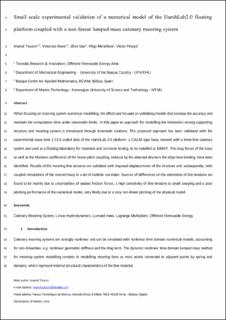| dc.contributor.author | Touzon, Imanol | |
| dc.contributor.author | Nava, Vincenzo | |
| dc.contributor.author | Gao, Zhen | |
| dc.contributor.author | Mendikoa, Iñigo | |
| dc.contributor.author | Petuya, Victor | |
| dc.date.accessioned | 2021-02-12T12:08:17Z | |
| dc.date.available | 2021-02-12T12:08:17Z | |
| dc.date.created | 2020-10-21T13:46:54Z | |
| dc.date.issued | 2020 | |
| dc.identifier.citation | Ocean Engineering. 2020, 200 . | en_US |
| dc.identifier.issn | 0029-8018 | |
| dc.identifier.uri | https://hdl.handle.net/11250/2727743 | |
| dc.description.abstract | When focusing on mooring system numerical modelling, the efforts are focused on validating models that increase the accuracy and maintain the computation time under reasonable limits. In this paper an approach for modelling the interaction among supporting structure and mooring system is introduced through kinematic relations. The proposed approach has been validated with the experimental wave tank 1:13.6 scaled data of the HarshLab 2.0 platform, a CALM type buoy moored with a three-line catenary system and used as a floating laboratory for materials and corrosion testing, to be installed at BiMEP. The drag forces of the buoy as well as the Morison coefficients of the heave-pitch coupling, induced by the attached structure for ships boat landing, have been identified. Results of the mooring line tensions are validated with imposed displacements of the structure and, subsequently, with coupled simulations of the moored buoy in a set of realistic sea states. Sources of differences on the estimation of line tensions are found to be mainly due to uncertainties of seabed friction forces, a high sensitivity of line tensions to small swaying and a poor pitching performance of the numerical model, very likely due to a very non-linear pitching of the physical model. | en_US |
| dc.language.iso | eng | en_US |
| dc.publisher | Elsevier | en_US |
| dc.rights | Attribution-NonCommercial-NoDerivatives 4.0 Internasjonal | * |
| dc.rights.uri | http://creativecommons.org/licenses/by-nc-nd/4.0/deed.no | * |
| dc.title | Small scale experimental validation of a numerical model of the HarshLab2.0 floating platform coupled with a non-linear lumped mass catenary mooring system | en_US |
| dc.type | Peer reviewed | en_US |
| dc.type | Journal article | en_US |
| dc.description.version | acceptedVersion | en_US |
| dc.source.pagenumber | 19 | en_US |
| dc.source.volume | 200 | en_US |
| dc.source.journal | Ocean Engineering | en_US |
| dc.identifier.doi | 10.1016/j.oceaneng.2020.107036 | |
| dc.identifier.cristin | 1841214 | |
| dc.description.localcode | "© 2020. This is the authors’ accepted and refereed manuscript to the article. Locked until 14.2.2022 due to copyright restrictions. This manuscript version is made available under the CC-BY-NC-ND 4.0 license http://creativecommons.org/licenses/by-nc-nd/4.0/ " | en_US |
| cristin.ispublished | true | |
| cristin.fulltext | postprint | |
| cristin.qualitycode | 1 | |

